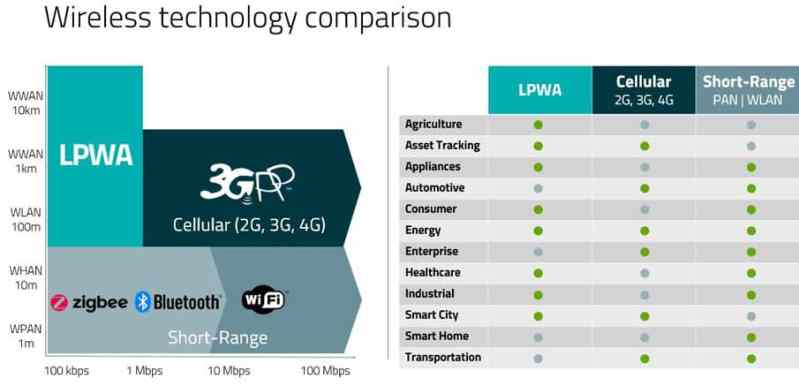What is a Low-Power Wide-Area (LPWA) network?
LPWA (sometimes called mobile IoT) networking technologies, such as LTE-M and NB-IoT, transmit data at slower rates than other cellular technologies. However, LPWA technologies also cost less, use less power, have better wireless coverage inside buildings, underground and in rural areas, and can transmit data to more devices in a condensed area than these other cellular technologies.
Five years ago, Low Power Wide Area (LPWA) technologies weren’t on the radar, however the Internet of Things was coming alive and taking off because people were inspired by the possibilities.
At that time, the market for connected things was small and mostly dominated by Personal Area Network (PAN) technologies, such as Bluetooth, and Wireless Local Area Network (WLAN) technologies, like Wi-Fi. With all the hype around IoT, many analysts were predicting there would be more than 20 billion connected devices by 2022.
Most of this volume was predicted to go to PAN/WLAN technologies, not to traditional cellular. That’s because PAN/WLAN technologies do a better job of meeting the cost and power requirements of IoT applications. However, these technologies provide little coverage, which is a key requirement for many IoT applications. Even traditional cellular, with its superior coverage, still has dead zones deep inside buildings or in very remote locations.
The core IoT application needs are what I call the four C’s: Cost (devices and services costs), Current (battery life), Coverage (reach) and Capacity (network).

Traditional cellular today only represents a small piece of the overall IoT market, primarily because it falls short on meeting all of the four C’s. Enter LPWA technology—a new category of wide area wireless technology specifically designed to meet the four C’s.
It’s important to note that no one technology will serve every IoT application. There are definitely applications where PAN/WLAN technologies, such as low energy Bluetooth, Zigbee and Wi-Fi, are still the clear choice. Traditional cellular also has its own unique set of advantages that PAN /WLAN and LPWA technologies cannot provide, such as full mobility at very high data rates and without the complexity and need to pair devices to an access point.

Re-engineering cellular for the IoT
As with many things in life, there are trade-offs, and designing wireless technology is no different. Traditional cellular has always been designed for consumer applications (e.g. smart phones and laptops), so the technology has been engineered to deliver higher and higher speeds to transmit more and more data in a very efficient way.
When it comes to IoT, many applications are happy with low data rates and only need to transmit small amounts of data, thus efficiency is not as big a concern compared to consumer applications, which send gigabytes of data. These differences allowed engineers to make tradeoffs that dramatically reduced the complexity but were unacceptable for traditional cellular.
As a result, cost savings are achieved as LPWA technologies require much less processing power and less memory. Low current results from the reduced processing and more opportunities to enter deep sleep. Higher coverage comes from slowing the data rate. And more capacity comes from the evolution of LTE networks to support a million connections per square kilometer. In short, LPWA technologies are designed from the ground up to meet those key four C’s for IoT.
Let’s look at some examples. If the objective of IoT is to connect as many objects as possible, we know that there is no single technology that is going to be perfect for everything.
Take connected home applications as an example. A furnace could be connected to a thermostat via Wi-Fi and, since the furnace and thermostat are not mobile, a WLAN technology provides the coverage required and thus makes it a suitable technology choice.
But what about services you want to bring into your home from third parties? Due to reliability concerns, a security service may not want to rely on your home Wi-Fi network to monitor your house and property. Here, using an LPWA technology that supports the data rate requirements and allows voice calls for the alarm panel might be the best fit. Moving outside the home, things like container and vehicle tracking devices would also be ideally suited for LPWA. As would tracking devices for your pets, children, or elderly parents.
However, LPWA technology is not well suited to creating mobile hotspots or high-rate video streaming services in vehicles, buses, and trains, due to the low data rates LPWA technologies provide, thus these applications are best serviced by traditional cellular technologies.
The applications and deployment scenarios are nearly infinite, but the bottom line is that LPWA technologies unlock the potential of IoT and open new IoT use cases by providing the three C’s, which other wireless technologies can’t provide.
My next posts will get into the many types of LPWA technologies—from proprietary solutions to decoding the alphabet soup of standardized technologies.
Looking for more information about LPWA? Start with Sierra to speak with one of our experts who can help you deploy the right LPWA technology for your application, or read the blog, LTE-M and NB-IoT: What to Know Before You Start Development. Download the whitepapers, LPWA: Separating Fact From Fiction, Coverage Analysis of LTE-M Category M1 and our What is LPWA? infographic.
Editor’s Note: This post was originally published in July 2016 and has been updated for accuracy and comprehensiveness.



